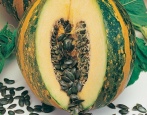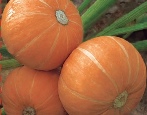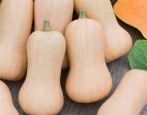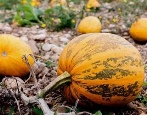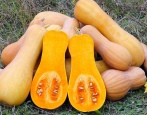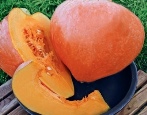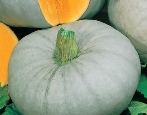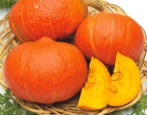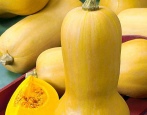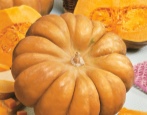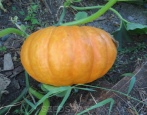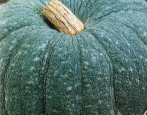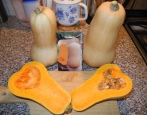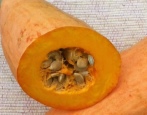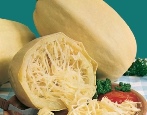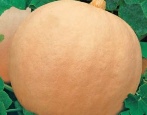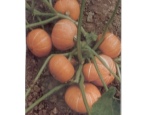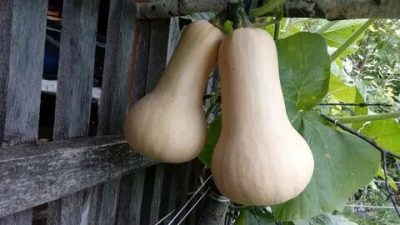
- Growth type: medium power
- The form: pear-shaped
- Weight, kg: 1,5-2,5
- Coloration: beige and cream
- Bark: thin, dense
- Color of the pulp: yellow-orange
- Pulp (consistency): dense
- Taste: sweet
- Disease and pest resistance: resistant to a complex of diseases
- Ripening terms: mid-season
Pumpkin Pineapple is a nutmeg variety that is appreciated by gardeners for its excellent taste characteristics, tender and juicy pulp. The creators of the culture gave it such a name because of its original taste: in addition to the nutty notes, here you can feel the taste of pineapple. And also thanks to the work of breeders, the hybrid has a strong immunity.
Description of the variety
Pineapple is a hybrid of the first generation butternut squash. The culture is highly transportable, has good keeping rates.
Belongs to a group of butternates, in Russia they are also called "guitar". There is quite a lot of pulp in the pumpkin, since the small seed chamber is at the bottom, where the pumpkin thickens. Interestingly, the pineapple-flavored vegetable doesn't smell like pumpkin at all. Fruits in autumn are characterized by starchiness, crispy pulp, and after November-December they become very sweet.
Characteristics of the appearance of plants and fruits
Pineapple gourd is a medium-vigorous, long-leaved plant that produces 5-6 vegetables at the same time. The shape of the pumpkins is pear-shaped, they are painted in beige and cream tones, the average weight is from 1.5 to 2.5 kg. The bark of Pineapple Gourd is thin but dense at the same time. The pulp is dense, yellow-orange in color. The fruits can be stored for a long time.
Purpose and taste
Pineapple pumpkin is so called because of its bright and sweet taste. It also differs in its nutmeg aroma, which only intensifies during storage. It shows itself well in a variety of dishes: you can make delicious snacks from it, it is a good addition to porridge. The vegetable puree turns out to be thick, without wateriness. Pineapple pumpkin is consumed both fresh and boiled, it can be stewed, dried, dried, frozen. You can also make preparations for the winter and, of course, this is an excellent dessert.
Pineapple is considered one of the healthiest and most delicious butternut squash, with a sugar content of up to 10%. It also has other useful properties and is widely used in dietary nutrition. The use of the product helps to improve digestion, metabolism, remove toxins from the body, as well as strengthen immunity.
Ripening terms
Pineapple is a mid-season vegetable. This butternut squash hybrid can be harvested 110-125 days after planting.
Yield
The crop is considered to be fruitful. So that fertility does not decrease, it is not recommended to plant more than 1 bush per 1 m2.
Growing and care
In order to grow a large harvest of Pineapple Pumpkin, it is important to observe the timing of planting the crop. In this case, you can grow a vegetable both seedling and non-seedling methods. For seedling sowing of seeds, they are performed in April-May, and the transfer of grown seedlings to open ground is carried out in May-June.
As for sowing seeds directly into the ground, it is carried out at the end of May, beginning of June. In this case, you must wait until the soil is warmed up to + 10-12 ° С.
Before sowing, in order to increase the percentage of germination, it is necessary to process (soak) the seed material. The planting itself is carried out in a hole, the depth of which is 5-6 cm.The optimal sowing pattern in the ground is 100x100 cm.
The place for planting the Pineapple pumpkin should be sunny, the described culture prefers spacious and bright areas. It is important to keep the plants free from drafts that harm the pumpkin. It is better to choose sandy or light loamy soil. It is not recommended to plant the hybrid variety next to zucchini and squash.
Disease and pest resistance
Since the Pineapple pumpkin is a hybrid, it has good resistance to a whole range of diseases.
